I already told you about my electrostatic headphones in previous post and now it’s time to look at another very interesting headphones from Stax that was made roughly at the same time. SR-40 is not an electrostatic headphones but “electret” ones. It’s very similar to electrostatics, only membrane there is thicker and already hold an electric charge to react in static field. With precharged membrane there is no need for addition electricity circuit just for build up a static charge, so it helps to reduce production cost. Beside it, electret technology considered inferior to electrostatics. Actually, all those electret headphones from Stax are dirt-cheap compared to more elaborate electrostatics and you can get them from Ebay for mere 50$-100$. So I decided that it’s not too expensive and have got one for myself.
That’s how they came to me – SR-40 electret headphones and SR-4 dedicated adapter. Initially Stax sells this combination as a set with name “SR-44”. If we can trust Stax product timeline on their website, SR-40 is their first commercial electret headphones. And SR-80MX that was introduced in 1990 was their last headphones of that type.
Shiny earcups casing, parts of a headband that hold earcups and headband itself made from stainless steel. Everything else is good hard plastic. Cable is wrapped in blue electric tape where it come out of earcup because it have broke there and I need to repair it somehow.
Once again Stax uses its own proprietary jack, but now there are only five pins instead of six, as in case with electrostatic headphones. Probably, that’s because electrets don’t need external source for creating static charge. Cable on this headphones made out of soft resin and not as tough as cloth-wrapped one in “New SR-3” model. Wire with dots go to the right earcup, while one with continuous white line go to the left earcup.
Similar to “New SR-3”, earcups holds in place only by spring force of the headband and can be easily removed. Actually, headband on this particular pair is insanely tight and with almost no padding on the part that rest on top of your head, it was impossible to wear them for more than fifteen minutes. So I unfold them a little and add some self-adhesive cushion on the headband (not pictured here).
 This part is made of plastic and probably the weakest part of whole headband assembly. As we can remember, headband on SR-3 is whole made out of stainless steel. And you can see that Stax makes even their cheapest headphones in Japan.
This part is made of plastic and probably the weakest part of whole headband assembly. As we can remember, headband on SR-3 is whole made out of stainless steel. And you can see that Stax makes even their cheapest headphones in Japan.
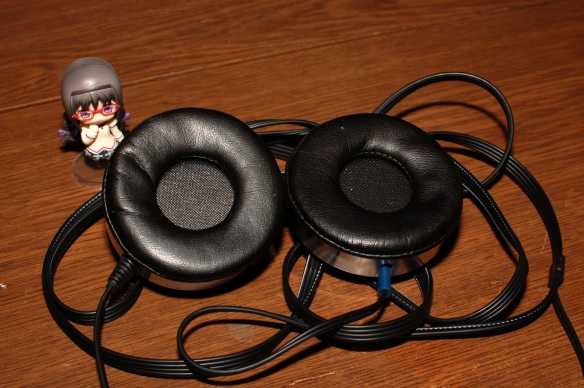 While membrane in this headphones have roughly similar size as one in “SR-3”, whole earcup is smaller, because they are made in supra-aural design where earpads presses against your ears and not around them.
While membrane in this headphones have roughly similar size as one in “SR-3”, whole earcup is smaller, because they are made in supra-aural design where earpads presses against your ears and not around them.
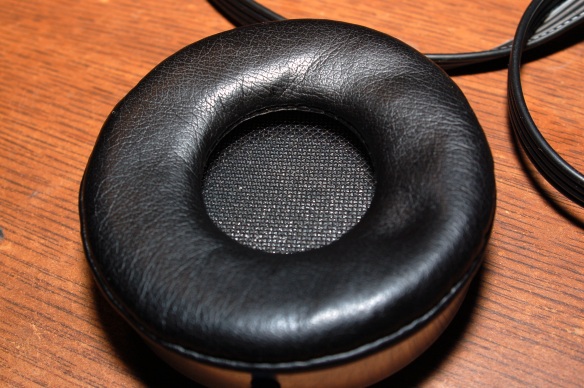 Earpads made out of very soft and comfy vinyl with little bit padding inside. They are glued to the earcups and can’t be taken off easily. Instead of holes in plastic case, in SR-40 Stax used fine steel mesh to separate your ears from transducer.
Earpads made out of very soft and comfy vinyl with little bit padding inside. They are glued to the earcups and can’t be taken off easily. Instead of holes in plastic case, in SR-40 Stax used fine steel mesh to separate your ears from transducer.
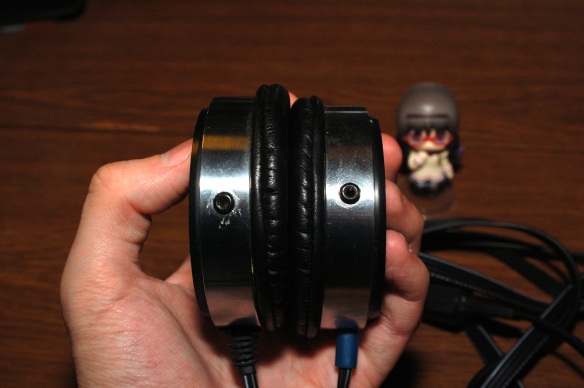 Those two plugs are where headband connects. Those shiny rings made out of steel and not plastic, as you can thought at first. My hands are of medium size, so you can probably guess size of the earcups.
Those two plugs are where headband connects. Those shiny rings made out of steel and not plastic, as you can thought at first. My hands are of medium size, so you can probably guess size of the earcups.
 Now lets try to disassemble those headphones. There are no screws in them, contrary to SR-3. So we just need to pull out those two little plugs on the side and lift black perforated plastic outer cover.
Now lets try to disassemble those headphones. There are no screws in them, contrary to SR-3. So we just need to pull out those two little plugs on the side and lift black perforated plastic outer cover.
So what we can see inside? Transducer is in the center, covered with some padding, while cable go around on the side and is soldered to some capacitor and transducer itself.
Outer cap made out from very hard plastic and holes in it additionally covered with fine synthetic fabric. As you can see, I grind part of it so it can accommodate my repair job on a cable.
 There is only steel inside. Padding is lightly glued to the transducer. As SR-3, this SR-40 electret headphones is semi-open type and there is outer side of the acoustic membrane under this padding.
There is only steel inside. Padding is lightly glued to the transducer. As SR-3, this SR-40 electret headphones is semi-open type and there is outer side of the acoustic membrane under this padding.
 Transducer glued to the case so that’s what happens when you try to pull it out. Adhesive allow it to be inserted and secured inside again though. You can see here perforated plate of the transducer under which sound membrane is hiding.
Transducer glued to the case so that’s what happens when you try to pull it out. Adhesive allow it to be inserted and secured inside again though. You can see here perforated plate of the transducer under which sound membrane is hiding.
 Now lets look at the adapter that is bundled with SR-40 headphones. Looks a lot like one that come with “New SR-3”, but it has only one socket for headphones and don’t has any power cable to plug it in a wall outlet.
Now lets look at the adapter that is bundled with SR-40 headphones. Looks a lot like one that come with “New SR-3”, but it has only one socket for headphones and don’t has any power cable to plug it in a wall outlet.
 Adapter named SRD-4 and has the same selector to bypass sound signal further to your loudspeakers. Headphones socket has only five holes you can’t plug in your electrostatic headphones that usually has six pins. On the other side, SR-40 and others electrets work well when plugged into normal-biased adapters for electrostatic headphones like SRD-5 that I reviewed at my previous post.
Adapter named SRD-4 and has the same selector to bypass sound signal further to your loudspeakers. Headphones socket has only five holes you can’t plug in your electrostatic headphones that usually has six pins. On the other side, SR-40 and others electrets work well when plugged into normal-biased adapters for electrostatic headphones like SRD-5 that I reviewed at my previous post.
 On the back side we only have cable that goes to a loudspeakers outputs of your amplifier and the terminals for cables to your loudspeakers, so you can bypass audio signal through adapter. This time Stax actually write which cable goes to which amp output. In case of SRD-5, you need to find this information in manual.
On the back side we only have cable that goes to a loudspeakers outputs of your amplifier and the terminals for cables to your loudspeakers, so you can bypass audio signal through adapter. This time Stax actually write which cable goes to which amp output. In case of SRD-5, you need to find this information in manual.
Whole case made out of steel and put together with hard stainless steel screws.
Now, lets look inside the adapter. There are fewer components than in SRD-5 adapter for electrostatic headphones, but transformers looks the same, except there are no wires for building static charge. Whole adapter is significantly lighter than SRD-5.
5 Watt and 27 Ohm? I wonder what is actual characteristics of this adapter, cause Stax share with us very few details.
Even small parts are made in Japan by Stax with great attention to details.
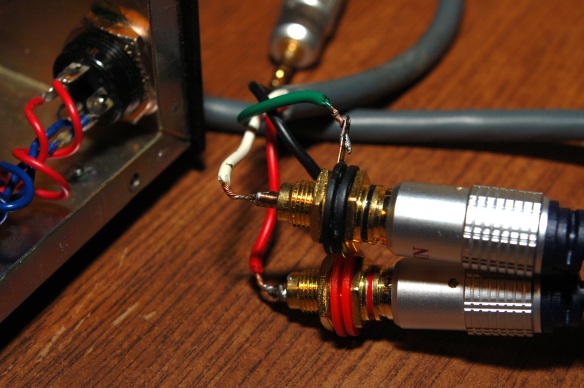 As with SR-3, I made some modification in the form of soldering RCA sockets to the wires so I can easily plug them into my headphone amp.
As with SR-3, I made some modification in the form of soldering RCA sockets to the wires so I can easily plug them into my headphone amp.
For the conclusion, I must admit that I like sound of my electret SR-40 more than of my electrostatic “New SR-3”. Sound of SR-40 is more crisp, clear and punchy than SR-3, while later sounds more flatter and relaxed. Much difference in sound actually come from their difference in design – SR-3 is circum-aural (around-the-ear) and SR-40 is supra-aural (against-the-ear).
But maybe it just because both of them needs dedicated amplifiers that work well with low impedance load (remember that they are intended to work in place of a full sized loudspeakers which are usually four to eight Ohm). I know that electrostatic loudspeakers are very tough for most stereo amplifiers cause their impedance can easily go down to 1,5-2 Ohms. In my case SR-40 is much easy to drive and their impedance probably higher than of SR-3 because they sounds like half quieter with same output from amplifier. SR-3 draw all the power they need from a wall outlet and probably can’t produce enough load in electric chain for amplifier to work properly.
I have plugged both of them directly to my Creative X-Fi sound card and they both works, but don’t go loud enough. So there was clearly not enough power for them. When I tried my Fiio E5 headphone amp with them, SR-40 works well but don’t go louder either, even with amp working at full power. When I raise volume at source, it just overloads inputs of Fiio E5. SR-3 when plugged into Fiio E5 plays with very audible distortion at most settings. So my evaluation on both of those headphones may change when I’ll get better amplifier to drive them (NwAvGuy, when will you release your O2 Desktop Amp?!).
As a bottom line, Stax electret headphones are dirt-cheap (100-150$ bundled with adapter) and sounds very good, but needs good amplifier and can be obtained only over Ebay secondhand, cause Stax don’t make them any more.

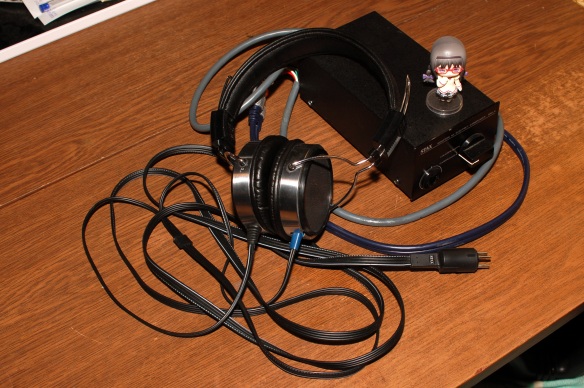
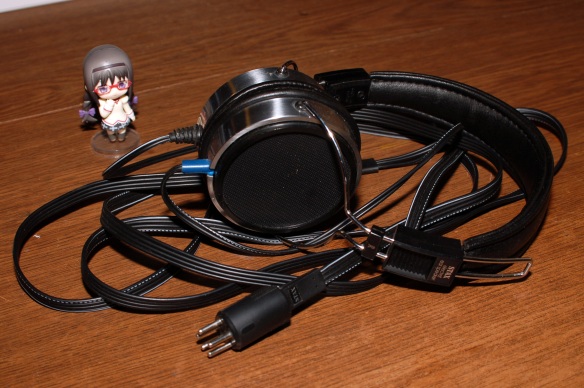


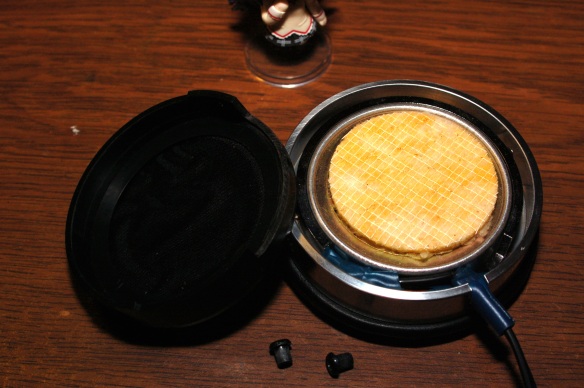


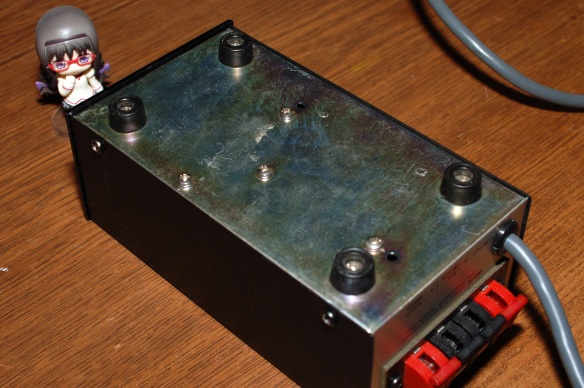


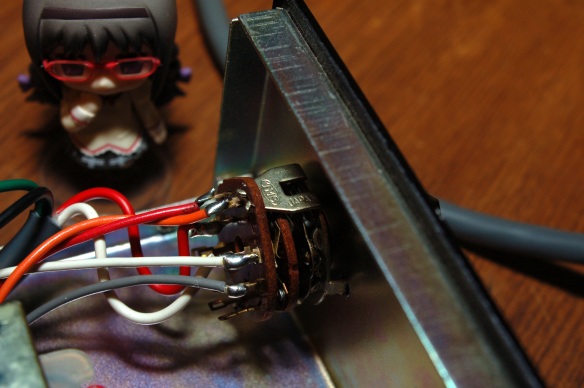
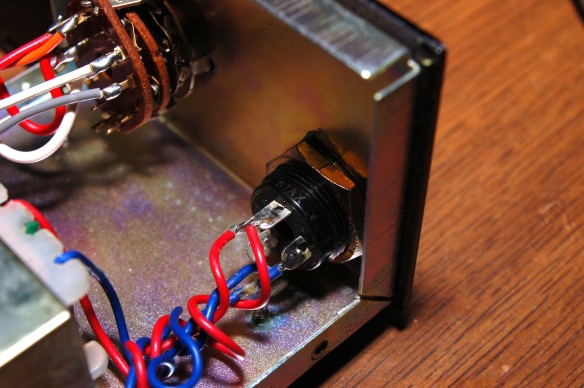
Great post! Thanks for the detail!
Great Post and great Headphone.
I wait one also: D
Try a stax headphone tube amp. With Lambda hélas phones. A pro one. It kills.
Those adapters are to be hooked up to a power amplifier, that is an amp made to drive speakers. A headphone amp doesn’t have enough power.
Yes, those adapters were intended to use with loudspeakers amplifiers back in eighties. But to my own surprise, they work well with PC soundcard and even with my Samsung Galaxy Tab. Though, can’t get very loud.
Hi, excellent article, than you. I bought them in the early 80s I think and left them years ago in the basement. IAfter reading your article, I found them again. You wrote : ” they work well with PC soundcard and even with my Samsung Galaxy Tab”. I cannot understand how you connect them. Can you elaborate please, thank you.
Glad you liked the article! You still need to plug those headphones into their respective adapter-energizer. But those adapters have four wires (plus and minus for left and right channel) that intended to be wired to speaker terminals (bolted down with nuts or clamped with spring loaded terminals) of your big speaker amplifiers. For use in modern application you need to solder those wires to 3,5 mm headphone jack to plug into modern headphone amp. First you need to check (in instruction manual or on the web) which color wire corresponds to plus or minus and which channel. For my SRD-4 electret adapter: RIGHT channel: red – signal, black – ground; LEFT channel: white – signal, green – ground. For RCA terminals signal wires must be soldered to the center and ground wires to the outer shell of the terminal. For headphone jack tip of the plug is left channel, next ring for right channel and the most outer ring is shared ground (you need to solder ground wires from both channels together). I was lazy and soldered those wires to RCA terminals and used RCA to 3,5 headphone jack cable to plug into headphone amplifier.
Thank you for your rapid reaction in my comments regarding STAX SR-44 electret. You presented some very detailed photos that permitted to understand better the idea of ” some modification in the form of soldering RCA sockets”! It is something I cannot do it.
I asked a hi-fi shop which sells newer STAX earphones and he propoed to take them to their shop to see the modifications needed. Also they proposed a ifi audio ZEN DAC version 2 amplifier as a solution for connection to laptop or smartphone. Its cost is 180 euros.
I am not sure of the way ahead.
If I solder the 4 wires, SR-40 would be useless from my KENWOOD stereo amplifier. For 156 euros I can buy the Bose Bose QuietComfort 35 II, so I could cover my laptop/smartphone needs via them, more economically. What would be your opinion on this?
Also a minor issue. Some times on the left earphone I stop hearing anything for milliseconds, it a problem at the connection of the wire to it base, if i hold it it works ok. How easy is to fix this? Thank you. I appreciate this.
Alex
A few years have gone by, but . . . I have the 30’s and the srd4. The transformers are buzzing at reasonable listening levels. I would like to replace them if possible but have no knowledge of transformers. Would you know what they are? Could you recommend replacements? Thanks!
I’m not an engineer so can’t help you there. Maybe it will be easy to just buy another adapter on Ebay. Stax design those adapters the clever way so most are interchangeable and compatible with various headphones. For example, you can plug electret headphones in normal bias socket of electrostatic adapter. I use my SR-40 with SRD-5 adapter (that initially was bundled with New SR-3 headphones) and it works perfectly.
Thank you for informative comments on the Stax Electret Earphones and condenser unit. I recently discovered this old set in a box that I moved into my house many years ago. I shall plug them into the speaker terminals of my Musical Fidelity integrated amp (75 wpc rms). Your review of the parts of these pieces of equipment may come in handy if it turns out that something has come loose inside.
You have also explained the difference between an electrostatic unit and an electret. Again, thank you.
In case people are curious, I bought these phones almost 40 years ago!
Just took delivery of a Stax SRS-44 system today and I’m really enjoying it. I have it hooked up to a Little Dot MK2 SE headphone amp (running its pre-outs to a Dayton Audio APA150) and the sound is quite good. As with any quality headphone, the SRS-44 will sound great with an excellent source and bad with a poor source. Pleasantly surprised at how well the SRS-44 has aged over the past forty three years.
Nice Website!
Jim
I feed my Stax SRS-44 system with an Adcom GFA-555 (and Phase Linear 2000 II preamp). You definitely have to turn up the volume, but well worth it. I bought them new back in the 80s, but replaced the headphones last year. I think playing the old ones too loud messed the old pair. I was listening to Santana’s live album Moonflower the other night, and as amazed at hearing the snap of a distant top hat simple, and even audience hand claps. I have always loved the airy clarity of these headphones (ear speakers in Stax parlance).